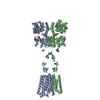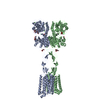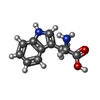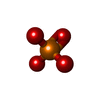[English] 日本語
 Yorodumi
Yorodumi- EMDB-45156: Structure of Calcium-Sensing Receptor in complex with positive al... -
+ Open data
Open data
- Basic information
Basic information
| Entry |  | |||||||||
|---|---|---|---|---|---|---|---|---|---|---|
| Title | Structure of Calcium-Sensing Receptor in complex with positive allosteric modulator '54149 | |||||||||
 Map data Map data | ||||||||||
 Sample Sample |
| |||||||||
 Keywords Keywords | G-protein coupled receptor / calcium-sensing / membrane protein | |||||||||
| Function / homology |  Function and homology information Function and homology informationbile acid secretion / chemosensory behavior / response to fibroblast growth factor / cellular response to peptide / cellular response to vitamin D / phosphatidylinositol phospholipase C activity / Class C/3 (Metabotropic glutamate/pheromone receptors) / calcium ion import / positive regulation of positive chemotaxis / fat pad development ...bile acid secretion / chemosensory behavior / response to fibroblast growth factor / cellular response to peptide / cellular response to vitamin D / phosphatidylinositol phospholipase C activity / Class C/3 (Metabotropic glutamate/pheromone receptors) / calcium ion import / positive regulation of positive chemotaxis / fat pad development / cellular response to hepatocyte growth factor stimulus / amino acid binding / branching morphogenesis of an epithelial tube / positive regulation of calcium ion import / regulation of calcium ion transport / cellular response to low-density lipoprotein particle stimulus / detection of calcium ion / anatomical structure morphogenesis / axon terminus / positive regulation of vasoconstriction / JNK cascade / chloride transmembrane transport / adenylate cyclase-inhibiting G protein-coupled receptor signaling pathway / ossification / response to ischemia / G protein-coupled receptor activity / cellular response to glucose stimulus / positive regulation of insulin secretion / intracellular calcium ion homeostasis / vasodilation / integrin binding / phospholipase C-activating G protein-coupled receptor signaling pathway / cellular response to hypoxia / G alpha (i) signalling events / basolateral plasma membrane / G alpha (q) signalling events / transmembrane transporter binding / positive regulation of ERK1 and ERK2 cascade / G protein-coupled receptor signaling pathway / apical plasma membrane / neuronal cell body / positive regulation of cell population proliferation / calcium ion binding / positive regulation of gene expression / protein kinase binding / cell surface / protein homodimerization activity / identical protein binding / plasma membrane Similarity search - Function | |||||||||
| Biological species |  Homo sapiens (human) Homo sapiens (human) | |||||||||
| Method | single particle reconstruction / cryo EM / Resolution: 2.8 Å | |||||||||
 Authors Authors | Wu C / Skiniotis G | |||||||||
| Funding support |  United States, 2 items United States, 2 items
| |||||||||
 Citation Citation |  Journal: Science / Year: 2024 Journal: Science / Year: 2024Title: Large library docking identifies positive allosteric modulators of the calcium-sensing receptor. Authors: Fangyu Liu / Cheng-Guo Wu / Chia-Ling Tu / Isabella Glenn / Justin Meyerowitz / Anat Levit Kaplan / Jiankun Lyu / Zhiqiang Cheng / Olga O Tarkhanova / Yurii S Moroz / John J Irwin / Wenhan ...Authors: Fangyu Liu / Cheng-Guo Wu / Chia-Ling Tu / Isabella Glenn / Justin Meyerowitz / Anat Levit Kaplan / Jiankun Lyu / Zhiqiang Cheng / Olga O Tarkhanova / Yurii S Moroz / John J Irwin / Wenhan Chang / Brian K Shoichet / Georgios Skiniotis /   Abstract: Positive allosteric modulator (PAM) drugs enhance the activation of the calcium-sensing receptor (CaSR) and suppress parathyroid hormone (PTH) secretion. Unfortunately, these hyperparathyroidism- ...Positive allosteric modulator (PAM) drugs enhance the activation of the calcium-sensing receptor (CaSR) and suppress parathyroid hormone (PTH) secretion. Unfortunately, these hyperparathyroidism-treating drugs can induce hypocalcemia and arrhythmias. Seeking improved modulators, we docked libraries of 2.7 million and 1.2 billion molecules against the CaSR structure. The billion-molecule docking found PAMs with a 2.7-fold higher hit rate than the million-molecule library, with hits up to 37-fold more potent. Structure-based optimization led to nanomolar leads. In ex vivo organ assays, one of these PAMs was 100-fold more potent than the standard of care, cinacalcet, and reduced serum PTH levels in mice without the hypocalcemia typical of CaSR drugs. As determined from cryo-electron microscopy structures, the PAMs identified here promote CaSR conformations that more closely resemble the activated state than those induced by the established drugs. | |||||||||
| History |
|
- Structure visualization
Structure visualization
| Supplemental images |
|---|
- Downloads & links
Downloads & links
-EMDB archive
| Map data |  emd_45156.map.gz emd_45156.map.gz | 467.7 MB |  EMDB map data format EMDB map data format | |
|---|---|---|---|---|
| Header (meta data) |  emd-45156-v30.xml emd-45156-v30.xml emd-45156.xml emd-45156.xml | 16.1 KB 16.1 KB | Display Display |  EMDB header EMDB header |
| Images |  emd_45156.png emd_45156.png | 67.4 KB | ||
| Filedesc metadata |  emd-45156.cif.gz emd-45156.cif.gz | 6.6 KB | ||
| Archive directory |  http://ftp.pdbj.org/pub/emdb/structures/EMD-45156 http://ftp.pdbj.org/pub/emdb/structures/EMD-45156 ftp://ftp.pdbj.org/pub/emdb/structures/EMD-45156 ftp://ftp.pdbj.org/pub/emdb/structures/EMD-45156 | HTTPS FTP |
-Validation report
| Summary document |  emd_45156_validation.pdf.gz emd_45156_validation.pdf.gz | 548.4 KB | Display |  EMDB validaton report EMDB validaton report |
|---|---|---|---|---|
| Full document |  emd_45156_full_validation.pdf.gz emd_45156_full_validation.pdf.gz | 548 KB | Display | |
| Data in XML |  emd_45156_validation.xml.gz emd_45156_validation.xml.gz | 6.9 KB | Display | |
| Data in CIF |  emd_45156_validation.cif.gz emd_45156_validation.cif.gz | 8.3 KB | Display | |
| Arichive directory |  https://ftp.pdbj.org/pub/emdb/validation_reports/EMD-45156 https://ftp.pdbj.org/pub/emdb/validation_reports/EMD-45156 ftp://ftp.pdbj.org/pub/emdb/validation_reports/EMD-45156 ftp://ftp.pdbj.org/pub/emdb/validation_reports/EMD-45156 | HTTPS FTP |
-Related structure data
| Related structure data |  9c2fMC  9c1pC C: citing same article ( M: atomic model generated by this map |
|---|---|
| Similar structure data | Similarity search - Function & homology  F&H Search F&H Search |
- Links
Links
| EMDB pages |  EMDB (EBI/PDBe) / EMDB (EBI/PDBe) /  EMDataResource EMDataResource |
|---|---|
| Related items in Molecule of the Month |
- Map
Map
| File |  Download / File: emd_45156.map.gz / Format: CCP4 / Size: 512 MB / Type: IMAGE STORED AS FLOATING POINT NUMBER (4 BYTES) Download / File: emd_45156.map.gz / Format: CCP4 / Size: 512 MB / Type: IMAGE STORED AS FLOATING POINT NUMBER (4 BYTES) | ||||||||||||||||||||||||||||||||||||
|---|---|---|---|---|---|---|---|---|---|---|---|---|---|---|---|---|---|---|---|---|---|---|---|---|---|---|---|---|---|---|---|---|---|---|---|---|---|
| Projections & slices | Image control
Images are generated by Spider. | ||||||||||||||||||||||||||||||||||||
| Voxel size | X=Y=Z: 0.75 Å | ||||||||||||||||||||||||||||||||||||
| Density |
| ||||||||||||||||||||||||||||||||||||
| Symmetry | Space group: 1 | ||||||||||||||||||||||||||||||||||||
| Details | EMDB XML:
|
-Supplemental data
- Sample components
Sample components
-Entire : Calcium-sensing receptor bound to compound '54149
| Entire | Name: Calcium-sensing receptor bound to compound '54149 |
|---|---|
| Components |
|
-Supramolecule #1: Calcium-sensing receptor bound to compound '54149
| Supramolecule | Name: Calcium-sensing receptor bound to compound '54149 / type: complex / ID: 1 / Parent: 0 / Macromolecule list: #1-#2 |
|---|---|
| Source (natural) | Organism:  Homo sapiens (human) Homo sapiens (human) |
-Macromolecule #1: Extracellular calcium-sensing receptor
| Macromolecule | Name: Extracellular calcium-sensing receptor / type: protein_or_peptide / ID: 1 / Number of copies: 1 / Enantiomer: LEVO |
|---|---|
| Source (natural) | Organism:  Homo sapiens (human) Homo sapiens (human) |
| Molecular weight | Theoretical: 108.023055 KDa |
| Recombinant expression | Organism:  |
| Sequence | String: WSHPQFEKGG GSGGGSGGSA WSHPQFEKGS AAAYGPDQRA QKKGDIILGG LFPIHFGVAA KDQDLKSRPE SVECIRYNFR GFRWLQAMI FAIEEINSSP ALLPNLTLGY RIFDTCNTVS KALEATLSFV AQNKIDSLNL DEFCNCSEHI PSTIAVVGAT G SGVSTAVA ...String: WSHPQFEKGG GSGGGSGGSA WSHPQFEKGS AAAYGPDQRA QKKGDIILGG LFPIHFGVAA KDQDLKSRPE SVECIRYNFR GFRWLQAMI FAIEEINSSP ALLPNLTLGY RIFDTCNTVS KALEATLSFV AQNKIDSLNL DEFCNCSEHI PSTIAVVGAT G SGVSTAVA NLLGLFYIPQ VSYASSSRLL SNKNQFKSFL RTIPNDEHQA TAMADIIEYF RWNWVGTIAA DDDYGRPGIE KF REEAEER DICIDFSELI SQYSDEEEIQ HVVEVIQNST AKVIVVFSSG PDLEPLIKEI VRRNITGKIW LASEAWASSS LIA MPQYFH VVGGTIGFAL KAGQIPGFRE FLKKVHPRKS VHNGFAKEFW EETFNCHLQE GAKGPLPVDT FLRGHEESGD RFSN SSTAF RPLCTGDENI SSVETPYIDY THLRISYNVY LAVYSIAHAL QDIYTCLPGR GLFTNGSCAD IKKVEAWQVL KHLRH LNFT NNMGEQVTFD ECGDLVGNYS IINWHLSPED GSIVFKEVGY YNVYAKKGER LFINEEKILW SGFSREVPFS NCSRDC LAG TRKGIIEGEP TCCFECVECP DGEYSDETDA SACNKCPDDF WSNENHTSCI AKEIEFLSWT EPFGIALTLF AVLGIFL TA FVLGVFIKFR NTPIVKATNR ELSYLLLFSL LCCFSSSLFF IGEPQDWTCR LRQPAFGISF VLCISCILVK TNRVLLVF E AKIPTSFHRK WWGLNLQFLL VFLCTFMQIV ICVIWLYTAP PSSYRNQELE DEIIFITCHE GSLMALGFLI GYTCLLAAI CFFFAFKSRK LPENFNEAKF ITFSMLIFFI VWISFIPAYA STYGKFVSAV EVIAILAASF GLLACIFFNK IYIILFKPSR NTIEEVRCS TAAHAFKVAA RATLRRSNVT GSSTNNNEEE KSRLLEKENR ELEKIIAEKE ERVSELRHQL QSRQQLKKTN UniProtKB: Extracellular calcium-sensing receptor |
-Macromolecule #2: Extracellular calcium-sensing receptor
| Macromolecule | Name: Extracellular calcium-sensing receptor / type: protein_or_peptide / ID: 2 / Number of copies: 1 / Enantiomer: LEVO |
|---|---|
| Source (natural) | Organism:  Homo sapiens (human) Homo sapiens (human) |
| Molecular weight | Theoretical: 105.938789 KDa |
| Recombinant expression | Organism:  |
| Sequence | String: DYKDDDDKAA AYGPDQRAQK KGDIILGGLF PIHFGVAAKD QDLKSRPESV ECIRYNFRGF RWLQAMIFAI EEINSSPALL PNLTLGYRI FDTCNTVSKA LEATLSFVAQ NKIDSLNLDE FCNCSEHIPS TIAVVGATGS GVSTAVANLL GLFYIPQVSY A SSSRLLSN ...String: DYKDDDDKAA AYGPDQRAQK KGDIILGGLF PIHFGVAAKD QDLKSRPESV ECIRYNFRGF RWLQAMIFAI EEINSSPALL PNLTLGYRI FDTCNTVSKA LEATLSFVAQ NKIDSLNLDE FCNCSEHIPS TIAVVGATGS GVSTAVANLL GLFYIPQVSY A SSSRLLSN KNQFKSFLRT IPNDEHQATA MADIIEYFRW NWVGTIAADD DYGRPGIEKF REEAEERDIC IDFSELISQY SD EEEIQHV VEVIQNSTAK VIVVFSSGPD LEPLIKEIVR RNITGKIWLA SEAWASSSLI AMPQYFHVVG GTIGFALKAG QIP GFREFL KKVHPRKSVH NGFAKEFWEE TFNCHLQEGA KGPLPVDTFL RGHEESGDRF SNSSTAFRPL CTGDENISSV ETPY IDYTH LRISYNVYLA VYSIAHALQD IYTCLPGRGL FTNGSCADIK KVEAWQVLKH LRHLNFTNNM GEQVTFDECG DLVGN YSII NWHLSPEDGS IVFKEVGYYN VYAKKGERLF INEEKILWSG FSREVPFSNC SRDCLAGTRK GIIEGEPTCC FECVEC PDG EYSDETDASA CNKCPDDFWS NENHTSCIAK EIEFLSWTEP FGIALTLFAV LGIFLTAFVL GVFIKFRNTP IVKATNR EL SYLLLFSLLC CFSSSLFFIG EPQDWTCRLR QPAFGISFVL CISCILVKTN RVLLVFEAKI PTSFHRKWWG LNLQFLLV F LCTFMQIVIC VIWLYTAPPS SYRNQELEDE IIFITCHEGS LMALGFLIGY TCLLAAICFF FAFKSRKLPE NFNEAKFIT FSMLIFFIVW ISFIPAYAST YGKFVSAVEV IAILAASFGL LACIFFNKIY IILFKPSRNT IEEVRCSTAA HAFKVAARAT LRRSNVTST SVTSVNQAST SRLEGLQSEN HRLRMKITEL DKDLEEVTMQ LQDTPEKKTN UniProtKB: Extracellular calcium-sensing receptor |
-Macromolecule #4: 2-acetamido-2-deoxy-beta-D-glucopyranose
| Macromolecule | Name: 2-acetamido-2-deoxy-beta-D-glucopyranose / type: ligand / ID: 4 / Number of copies: 5 / Formula: NAG |
|---|---|
| Molecular weight | Theoretical: 221.208 Da |
| Chemical component information |  ChemComp-NAG: |
-Macromolecule #5: CALCIUM ION
| Macromolecule | Name: CALCIUM ION / type: ligand / ID: 5 / Number of copies: 8 / Formula: CA |
|---|---|
| Molecular weight | Theoretical: 40.078 Da |
-Macromolecule #6: TRYPTOPHAN
| Macromolecule | Name: TRYPTOPHAN / type: ligand / ID: 6 / Number of copies: 2 / Formula: TRP |
|---|---|
| Molecular weight | Theoretical: 204.225 Da |
| Chemical component information |  ChemComp-TRP: |
-Macromolecule #7: PHOSPHATE ION
| Macromolecule | Name: PHOSPHATE ION / type: ligand / ID: 7 / Number of copies: 2 / Formula: PO4 |
|---|---|
| Molecular weight | Theoretical: 94.971 Da |
| Chemical component information |  ChemComp-PO4: |
-Macromolecule #8: (1R)-1-(2H-1,3-benzodioxol-4-yl)-N-[2-(1,2-benzothiazol-3-yl)ethy...
| Macromolecule | Name: (1R)-1-(2H-1,3-benzodioxol-4-yl)-N-[2-(1,2-benzothiazol-3-yl)ethyl]ethan-1-amine type: ligand / ID: 8 / Number of copies: 2 / Formula: A1ATX |
|---|---|
| Molecular weight | Theoretical: 326.413 Da |
-Experimental details
-Structure determination
| Method | cryo EM |
|---|---|
 Processing Processing | single particle reconstruction |
| Aggregation state | particle |
- Sample preparation
Sample preparation
| Buffer | pH: 7.5 |
|---|---|
| Vitrification | Cryogen name: ETHANE / Chamber humidity: 100 % / Chamber temperature: 277 K / Instrument: FEI VITROBOT MARK IV |
- Electron microscopy
Electron microscopy
| Microscope | FEI TITAN KRIOS |
|---|---|
| Image recording | Film or detector model: GATAN K3 (6k x 4k) / Average electron dose: 50.0 e/Å2 |
| Electron beam | Acceleration voltage: 300 kV / Electron source:  FIELD EMISSION GUN FIELD EMISSION GUN |
| Electron optics | Illumination mode: FLOOD BEAM / Imaging mode: BRIGHT FIELD / Nominal defocus max: 1.5 µm / Nominal defocus min: 0.5 µm |
| Experimental equipment |  Model: Titan Krios / Image courtesy: FEI Company |
- Image processing
Image processing
| Startup model | Type of model: PDB ENTRY PDB model - PDB ID: |
|---|---|
| Final reconstruction | Resolution.type: BY AUTHOR / Resolution: 2.8 Å / Resolution method: FSC 0.143 CUT-OFF / Number images used: 318351 |
| Initial angle assignment | Type: MAXIMUM LIKELIHOOD |
| Final angle assignment | Type: MAXIMUM LIKELIHOOD |
 Movie
Movie Controller
Controller












 Z (Sec.)
Z (Sec.) Y (Row.)
Y (Row.) X (Col.)
X (Col.)





















